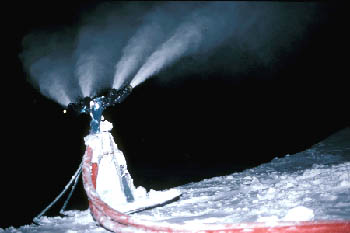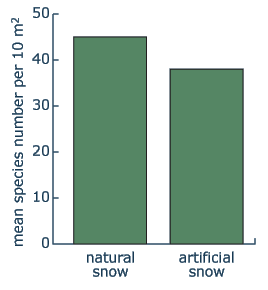 |
|
|
|
|
|
|
1 - High pressure snow making equipment in action. |
Global warming affects snow reliability in many winter sports
resorts between 1200 and 1800 m in the European Alps. To deal with this
problem, tourism managers consider guaranteeing winter sports by intensifying
artificial snow-making. However, knowledge of the impact of artificial
snow on ecosystems and especially on vegetation is still rudimentary. |
|
|
|
A study conducted in Savognin (eastern Swiss Alps), where artificial snow-making has been carried out every year since 1978, has revealed that artificial snow leads to significant changes in the floristic composition of high montane and subalpine grasslands. Figure 2 compares the floristic composition with and without artificial snow. |
|
|
|
The cover of species typical of nutrient-rich hay meadows was higher on dry and nutrient-poor hay meadows that are covered with artificial snow in winter when compared to the untreated meadows. On the other hand, the cover of species typical of dry and nutrient-poor meadows decreased in the meadows with artificial snow. This shift of the floristic composition was connected to a decline in the total species number of the meadows sprayed with artificial snow. |
|
3 - A species-rich hay meadow dominated by Bromus erectus and Helictotrichon pubescens in the Savognin region. |
4 - Comparison of species richness in nutrient-poor hay meadows |
| |
| The additional water and ion inputs on the sites sprayed with artificial snow and the prolongation of the snow cover are likely to be the causes of the floristic changes described.
Each of these factors promotes the faster growing species typical of nutrient-rich, mesic habitats at the expense of weaker competitors such as the species of low-nutrient and drier habitats thereby leading to the vegetation changes observed. In conclusion, artificial snow represents a serious threat to the plant species diversity of low-nutrient and dry grasslands. |
5 - Remains of artificial snow in a skiing area in late April. |
| |
| |
Compare the phenological development of the vegetation on meadow sprayed with artificial snow to that of an untreated meadow (natural snow) from early May to late June. |
29 August 2011 |
||
| |
||




